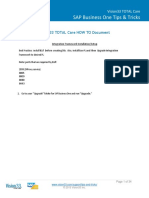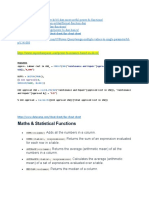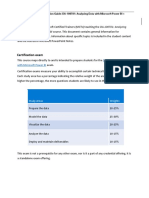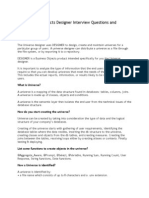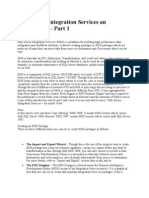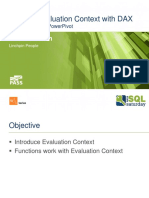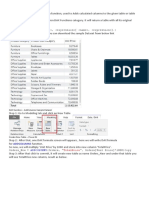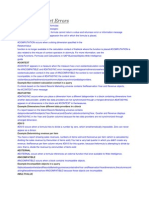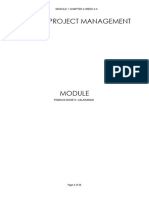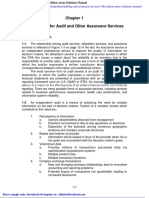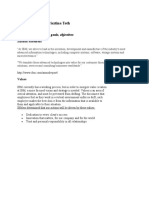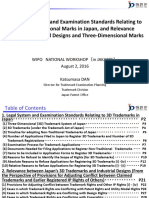Calculated columns with DAX
An introduction to DAX
Please do not copy without permission. © ExploreAI 2023.
�Calculated columns with DAX
DAX The language of data in Power BI
Data Analysis Expressions (DAX) is a How to input DAX in Power BI
programming language that is used in Power BI
to create calculated columns, measures, and We input DAX code by selecting the
custom tables. Modeling tab in Report view or the Table
tools tab in Table view and choosing the
appropriate option:
It is a collection of functions, operators, and
constants that can be used in formulas to perform
advanced calculations and data analysis.
A formula bar pops up where we can type
our DAX code:
It allows us to write custom calculations using
the formula bar and return one or more values.
2
�Calculated columns with DAX
Composing formulas in DAX
| Every DAX formula is a combination of functions, operators, and constants. Understanding
how these work together is key to mastering DAX.
Predefined formulas that perform specific calculations using the data in our tables, such
Functions
as adding up numbers or finding an average.
Symbols or keywords that specify the type of calculation to perform between elements
Operators
in a formula, like adding with “+ˮ or multiplying with “*ˮ.
Fixed values that we directly enter into our formulas, such as a number, a text string, or a
Constants
date.
3
�Calculated columns with DAX
Using DAX with data
We will use a subset of the Gender_parity_2022 dataset to illustrate how we
use DAX.
Country Percent_literacy_women Percent_literacy_men GDP_per_capita_USD Population_size
Egypt 67.38999939 78.77999878 4,295.40 110,990,103
Ethiopia 44.42338181 59.24145889 1,027.60 123,379,924
Ghana 76.19000244 84.48999786 2,175.90 33,475,870
Kenya 79.84999847 85.48000336 2,099.30 54,027,487
Morocco 67.37999725 84.80999756 3,527.90 37,457,971
Rwanda 73.30000305 78.69999695 966.3 13,776,698
Nigeria 52.65647888 71.25570679 2,184.40 218,541,212
South Africa 94.53317261 95.54537201 6,776.50 59,893,885
4
�Calculated columns with DAX
Calculated columns
| A calculated column is a new column that we add to a table that is computed from other
columns.
Unlike a regular column, a calculated column uses a DAX formula that
Literacy_difference
defines its values. These are stored in the model and can be used in reports
just like any other column. -11.38999939
This isn't just about displaying new information, it's about creating it from -14.81807708
what we already have. -8.29999542
-5.63000489
To understand the balance between female and male literacy rates, we could create
-17.43000031
a calculated column that stores the difference between these values.
-5.3999939
DAX Literacy_difference = 'Gender_parity_2022'[Percent_literacy_women]- -18.59922791
'Gender_parity_2022'[Percent_literacy_men] -1.0121994
5
�Calculated columns with DAX
How are values in the calculated column determined?
| Row context tells DAX which row to use when determining the values for the calculated
column.
We can think of the row context as the current row under calculation in a table. Itʼs like having a magnifying
glass that looks at each row one by one during the calculation.
For example, DAX used row context to subtract the value of Percent_literacy_men from
Percent_literacy_women, row by row, and then stored the result in the same row in the
Literacy_difference column. The key to understanding the row context is in that “row by rowˮ.
.E.g., Use the. Percent_literacy_women Percent_literacy_men Literacy_difference .To determine the value in.
.values in. .the same row in the.
.this row. 67.38999939 78.77999878 -11.38999939 .calculated column.
6
�Calculated columns with DAX
Other places we can use DAX
| In addition to calculated columns, DAX also empowers us to create measures and tables, to
further analyse and summarise our data.
Measure Table
● Measures are calculations created using DAX that ● Custom tables can be created using DAX to
are computed dynamically based on the current organise data in new ways or summarise it for
report context. specific views.
● They are often used to perform summarisation ● They allow us to combine data from multiple
operations like sum, average, or count, that work sources and store it within the Power BI model.
across the entire table or within the filters set by ● These tables can include calculated columns for
users, not just row by row. specific analysis needs, and measures can be
● Unlike calculated columns, measures do not store used alongside these tables to provide dynamic
their results in the database – they're summaries.
re-calculated whenever needed.
7
�Calculated columns with DAX
Choosing between a calculated column or a measure
Calculated column Measure
Used to add new data to an existing table, Used to aggregate data, providing high-level
Purpose
expanding its detail. summaries and insights.
Created using row context and is computed during Evaluated when a query is made based on the
Evaluation data refresh, becoming a permanent part of the current filters we have set, allowing dynamic
table. calculation based on the current view.
Becomes part of the table's storage (in import
Doesnʼt store data – it calculates on demand and is
Storage mode) and can influence report size and
typically more efficient for summarisation.
performance.
Can be used like any other column to sort, filter, and Typically used in visuals to present aggregated
Visual use
group data in reports. data, such as totals or averages.
8
�Calculated columns with DAX
Functions in Power BI
DAX functions
Functions are prewritten formulas that we can use to perform operations on data. They can be as simple
as adding two numbers or as complex as filtering a table based on multiple conditions.
In DAX, these functions are enhanced by the ability to reference various model objects like tables,
columns, and measures, enabling refined and powerful data calculations within our Power BI reports.
For example, to analyse literacy rate trends by gender, we could use the AVERAGE function on
Percent_literacy_women and Percent_literacy_men.
Average_women_literacy_rate = AVERAGE('Gender_parity_2022'[Percent_literacy_women])
Average_men_literacy_rate = AVERAGE('Gender_parity_2022'[Percent_literacy_men])
9
�Calculated columns with DAX
Referencing model objects
|
In DAX, we can reference entire tables, specific columns within tables, or measures that we've
already created. This allows for a modular approach where measures can build on each other
and on calculated columns.
Table references Column references Measure references
Refers to the entire table within Refers to specific columns within Refers to measures that have
the data model. Used in functions a table. Used when we need to been defined in the model. Allows
that need to consider the entire perform operations on particular the reuse of measures within
dataset. fields, such as creating other DAX formulas, maintaining
calculated columns or defining consistency and reducing
criteria in filters. redundancy in calculations.
Syntax: Syntax: Syntax:
‘Table_name’ ‘Table_name’[Column_name] [Measure_name]
10
�Calculated columns with DAX
Bringing it all together
Letʼs create a measure that calculates the average GDP for countries with a female literacy rate above 70%.
1. First, we define a measure called Average_GDP_per_capita to calculate the average GDP.
Table reference
Average_GDP_per_capita = AVERAGE ( ‘Gender_parity_2022’ [GDP_per_capita_USD] ) Column reference
Function
2. Next, we create a measure that calculates the average GDP for countries with a female literacy rate above 70%.
Function
Avg_GDP_for_high_female_literacy =
CALCULATE (
Measure reference
[Average_GDP_per_capita] ,
'Gender_parity_2022' [Percent_literacy_women] > 70
) Filter
Column reference
11























